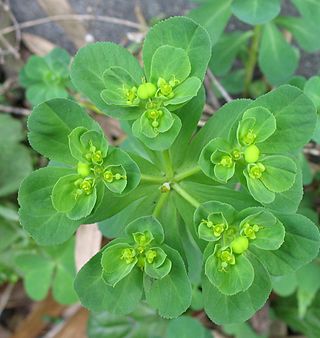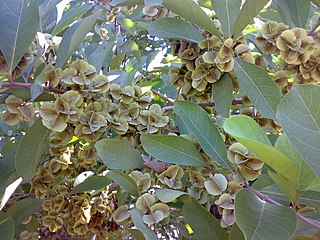Related Research Articles

Gallic acid (also known as 3,4,5-trihydroxybenzoic acid) is a trihydroxybenzoic acid with the formula C6H2(OH)3CO2H. It is classified as a phenolic acid. It is found in gallnuts, sumac, witch hazel, tea leaves, oak bark, and other plants. It is a white solid, although samples are typically brown owing to partial oxidation. Salts and esters of gallic acid are termed "gallates".

Euphorbia helioscopia, the sun spurge or madwoman's milk, is a species of flowering plant in the spurge family Euphorbiaceae. It is a herbaceous annual plant, native to most of Europe, northern Africa, and eastward through most of Asia.

Glucuronic acid is a uronic acid that was first isolated from urine. It is found in many gums such as gum arabic, xanthan, and kombucha tea and is important for the metabolism of microorganisms, plants and animals.

Combretum quadrangulare, or commonly known as sakae naa, is a small tree of the family Combretaceae, up to 10 m high. The tree grows wildly or is planted in Vietnam, Cambodia, Laos, Myanmar and Thailand.
The enzyme tannase (EC 3.1.1.20) catalyzes the following reaction:
In enzymology, a beta-glucogallin O-galloyltransferase is an enzyme that catalyzes the chemical reaction
In enzymology, a beta-glucogallin-tetrakisgalloylglucose O-galloyltransferase is an enzyme that catalyzes the chemical reaction.
In enzymology, a 4-hydroxybenzoate 4-O-beta-D-glucosyltransferase is an enzyme that catalyzes the chemical reaction
In enzymology, a gallate 1-beta-glucosyltransferase is an enzyme that catalyzes the chemical reaction
A hydrolysable tannin or pyrogallol-type tannin is a type of tannin that, on heating with hydrochloric or sulfuric acids, yields gallic or ellagic acids.
The ellagitannins are a diverse class of hydrolyzable tannins, a type of polyphenol formed primarily from the oxidative linkage of galloyl groups in 1,2,3,4,6-pentagalloyl glucose. Ellagitannins differ from gallotannins, in that their galloyl groups are linked through C-C bonds, whereas the galloyl groups in gallotannins are linked by depside bonds.

Glucogallin is chemical compound formed from gallic acid and β-D-glucose. It can be found in oaks species like the North American white oak, European red oak and Amla fruit.
1O or 1-O may refer to:

1,2,3,4,6-Pentagalloylglucose is the pentagallic acid ester of glucose. It is a gallotannin and the precursor of ellagitannins.

The pomegranate ellagitannins, which include punicalagin isomers, are ellagitannins found in the sarcotestas, rind (peel), bark or heartwood of pomegranates.

Terminalia myriocarpa, the East Indian almond, is a tree species in the genus Terminalia found in Southeast Asia.

Sanguisorbic acid is a constituent of some ellagitannins. It is constituted by a hexahydroxydiphenic acid unit linked by an O-C bond to a gallic acid. The differences with its isomers, valoneic acid and nonahydroxytriphenic acid, are that the hydroxyl that links the hexahydroxydiphenoyl (HHDP) group to the galloyl group belongs to the galloyl group in valoneic acid, while in nonahydroxytriphenic acid, the hexahydroxydiphenic acid unit is linked by a C-C bond to gallic acid.

Elaeocarpus sylvestris, the woodland elaeocarpus, is a tree species in the genus Elaeocarpus.

4-Hydroxybenzoic acid 4-O-glucoside is a glucoside of p-hydroxybenzoic acid. It can be found in mycorrhizal and non-mycorrhizal roots of Norway spruces.
References
- ↑ Cammann, Jessica; Denzel, Klaus; Schilling, Gerhard; Gross, Georg G. (August 1989). "Biosynthesis of gallotannins: β-Glucogallin-dependent formation of 1,2,3,4,6-pentagalloylglucose by enzymatic galloylation of 1,2,3,6-tetragalloylglucose". Archives of Biochemistry and Biophysics. 273 (1): 58–63. doi:10.1016/0003-9861(89)90161-6. PMID 2757399.